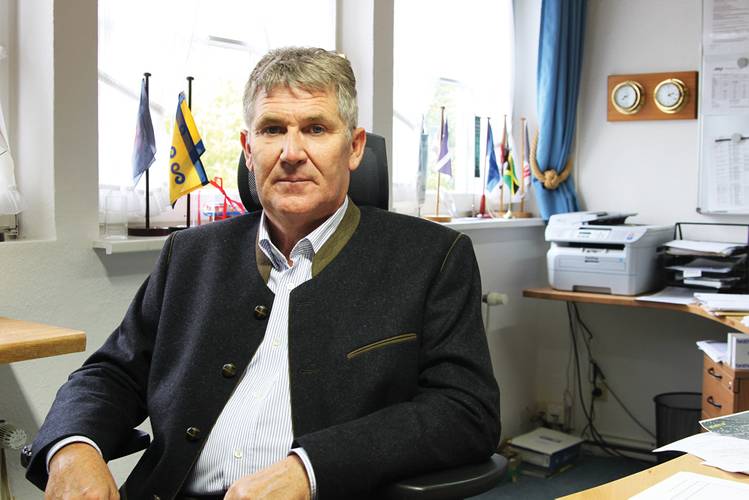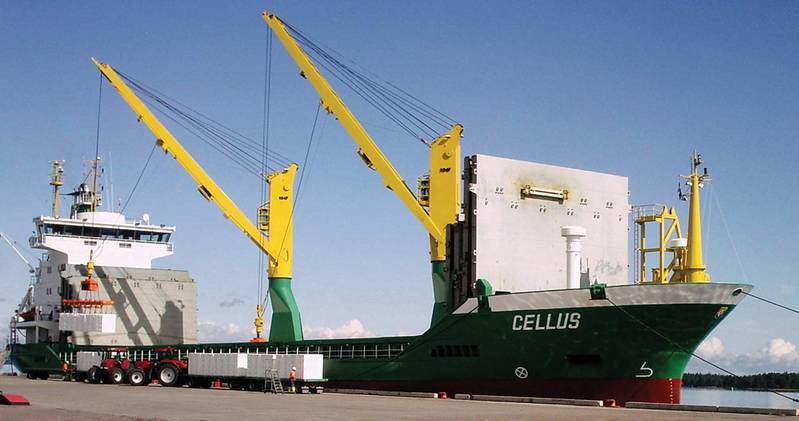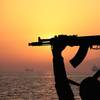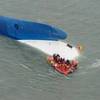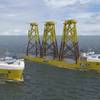MV Cellus
It’s not new, but is MV Cellus one of the cleanest ship in the world?
Quick question: When the words “Green Shipping” and “German Maritime” are put together, is the first thought in your mind modern cruise ships? If you answered yes, it would be understandable; but partially right, partially wrong. Recently Maritime Reporter & Engineering News German-based contributing editor Dipl.-Ing. Peter Pospiech climbed on board the MV CELLUS – a German freighter – to uncover some of the secrets that make it a clean operating ship, in fact so clean that it fulfills the stringent requirements of the Blue Angel Award, and warrants feature in Maritime Reporter & Engineering News’ “Great Ships of 2012.”
A simple German freighter is a bonafide trendsetter for clean ships operation, becoming the first seagoing ship to earn the “Blue Angel” eco-label, the oldest eco-labeling of Europe. The UN forwarded the eco-label into the hands of the German Ministry for the Environment, Nature Conservation and Nuclear Safety – for the award of environmental products and services.
When climbing aboard the MV Cellus the first thing that you see on the superstructure is a big sign – the “Blue Angel” mark – which is a sign that is most frequently seen on toilet paper or milk cartons, as the Blue Angel is most closely associated with and conferred upon consumer products.
But the MV Cellus, built by Peters Schiffbau, Wewelsfleth, Germany, and owned by R. Braren, of Kollmar, Germany, is a ship that stands out, and has earned its Blue Angel wings courtesy not of a single product or system, rather a collection of system and process from;
• its controlled waste and sanitation
management, to
• its non-toxic underwater paint, to
• its scrubbed emissions, to
• its full complement of safety
equipment, and not to mention
• its good human resource
management.
“The decisive factor has been indeed the reduction of exhaust gas pollutants,” said Chief Jürgen Beller, “more precisely: the limitation of sulfurous matter in the fuel as well as the reduction of nitrogen oxide and particulate emission.”
On November 21, 2002, the most significant German “Blue Angel” eco-label was been awarded to the ship in the town of Kollmar, next to the river Elbe based, captain and shipping owner Rörd Braren.
In addition, in June of 2004 the ship owner was conferred what is essentially the “Environmental Oscar” by the EU Commission the “Clean Marine Award” for all three special cellulose freighters: Cellus, Timbus and Forester “for his pioneering feat at the practice of environmentally friendly technologies in ship operations.”
Södra Cell, with approximately two million tons annually, is one of the world’s leading manufacturers of paper pulp for the open market, has a strong environmental protection mandate. Södra prioritizes continued development of next-generation renewable, recyclable and biodegradable products. In addition, the company strives to ensure that the transportation it uses and employes is ecologically harmless.
“We cannot make only promises, but have to implement them,” said Jan Gyllen, CEO of Södra Shipping. Thus his proposal, to build a “clean ship” fell on fertile ground. In his business partner Rörd Braren and the Peters-Shipyard in Wewelsfleth he found competent and willing participants, and together they designed what is self-described as worldwide the first ship with the eco-label.
Words & Actions
While many shipowners, particularly when the Cellus was built in 1998, were more talk than action on environmental matters, this was not the case with this group. Besides ship safety, the subject of environmental protection is written in bold letters across the project, courtesy of a family of advanced environmental products and systems that, when installed, were more the realm of marketing fodder than actionable items for other shipowners.
Specifically, all ships are painted with an environmentally (non-toxic) marine paint; sewage water and waste are collected on board and are disposed of on shore; a cathodic corrosion protection on the ship hull of the CELLUS has been installed; and an impressed Current Cathodic Protection (ICCP) system uses the principle of shifting the natural potential of metals, protecting the ship durably and effectively against corrosion. The ICCP-system provides the ships with all-round protection, including the protection for the propulsion and rudder system.
However, the most important factor was the installation of a selective catalytic reduction system (SCR). “With the help of injected urea as reduction agent up to approximately 95% nitrous gases are changed chemically into non-toxic and harmless exhaust,” said Chief Jürgen Beller. The defined dose of urea is sprayed through a nozzle into the stream of exhaust, where it is first subject to hydrolysis, and then causes the transformation of the nitrogen monoxide (NOx) into nitrogen (N) and water (H2O) in the catalytic converter. Urea consumption, according to the shipping company, is about 7% from fuel consumption. But pre-condition for the application of SCR-systems is the use of low-sulfur fuel. Low-sulfur fuel is very important for most of the exhaust after treatment systems. All kinds of catalyst suffer from the impact of sulfur: premature aging, deterioration and contamination of the catalytic coating and also the ceramic support material. The ordinary oxidation catalysts maintain furthermore the sulfate formation; thus the exhaust will be enriched with toxic substances and the corrosion of the exhaust system accelerated.
Cellus’ bunker capacity is about 340 tons of low-sulfur fuel, LS IFO 380 (sulfur content: 0.6 to 0.9%), which reduces the toxic substances in the exhaust. Cost per ton in October on the Rotterdam market: about $680 (in comparison: MGO LS with only 0.1% sulfur content: $958)
“Protection for human beings and the environment, even with our daily consumption of only 14 tons of fuel,” Chief Beller summed up, “but it only makes sense if everybody participates. Much more needs to be done to get worldwide binding standards to create equal competition conditions between all shipping nations.”
The emergence of ECAs across much of Europe and North America, with its stringent limits on sulfur in marine fuel and the resulting benefits to the environment, are a good step forward.
“If everybody would follow,” said Capt. Seemann, “the polluting emissions could be reduced by approximately 40% in the area of the North- and Baltic Sea.” That is a must inside the SECA’s and will be controlled by the authorities from time to time. The German Ministry of Environment sees a long-term reduction of around 96% for SOx (compared to fuel with 2.7%) based on the revision of MARPOL ANNEX VI (2008), and around 83% for the particulate mass-fraction.
“Technically high-quality ships do have the best chances on the charter market. Also in the case of resale they realize higher proceeds,” said the owner, Braren.
He and the Södra-Group together have worked to building, maintaining and operating technically advanced ships. And while the common notion is that higher specification ships can put an owner at a competitive disadvantage, Braren scoffs at the notion. “The contrary is the case: my certified ships are on long-term charter. Swedish ports have implemented a stepped system of port charges. For an eco-ship that brings up to $7,700 savings, and this for each port come in.”
MV Cellus Main Particulars
Owner R.Braren, Kollmar, Germany
Shipyard Peters Schiffbau, Wewelsfleth, Germany
Certificate +GL 100A5 E2 G, MC E2 AUT
Main engine 1 x MaK
Model/power/ speed MaK 8M32, 3,840 kW @ 600rpm
Variable pitch propeller Wärtsilä/Lips
Aux.-engine 1 x MAN, 6L16/24; [email protected]
Emergency genset 1 x Volvo TAMD 122A, [email protected]
Shaft generator 1 x Piller Group GmbH, Germany, 982 kVA
SCR catalysator for main and aux engine 1x Siemens Sinox
Hull Paint Wilckens, non-toxic tin-free
Cathodic Corrosion Protection Corrobesch
Verfahrenstechnik GmbH, Germany
Heavy lift deck cranes 2 x NMF Neuenfelde, Germany
Oil & fuel separators Westfalia GmbH, Germany
Fresh water generator Alfa Laval
Urea Tank 1 Stainless Steel, capacity 50 t
Year of Build` 1998
Yard Number 453
Length 99.99 m
Breadth 17 m
Draft 7.27 m
DWT 6389
Speed 15 knots
Crew 12
The Blue Angel Eco-Label with Brand Character
The Blue Angel (http://www.blauer-engel.de) touts itself as the first and oldest environment-related label for products and services in the world. Created in 1978 on the initiative of the Federal Minister of the Interior and approved by the Ministers of the Environment of the federal government and the federal states, it considers itself as a market-conform instrument of environmental policy designed to distinguish the positive environmental features of products and services on a voluntary basis.
The first Basic Award Criteria were adopted by the Environmental Label Jury in 1978. Today, about 11,700 products and services in circa 120 product categories carry the Blue Angel eco-label.
Most of them are consumer products. One of them is a seagoing freighter.
The aim of awarding the Blue Angel eco-label to environmentally sound ship operations is to help reduce the emissions and releases of pollutants into the marine environment caused by a seagoing vessel. To achieve this aim particularly high standards are imposed on the management of shipping companies and ships, on ship design and equipment, and especially on the measures for the reduction of emissions. The scope of this Blue Angel comprises the operation on ships sailing under the German or a foreign flag. Excluded are, among others, tank ships, fishing vessels as well as sport boats and navy ships.
Currently, 1158 suppliers have concluded a Contract on the Use of the Blue Angel. 22 percent of them are foreign suppliers. A total of about 11,500 products are Blue Angel eco-labeled.
(As published in the December 2012 edition of Maritime Reporter - www.marinelink.com)





